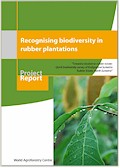| Report |
 |
|
| Title | Recognising biodiversity in rubber plantations | | Author | Hesti L. Tata, Elok Mulyoutami, Zuraidah Said, Harti Ningsih, Asep Ayat and Pandam Nugroho Prasetyo | | Editor | Hesti L. Tata | | Year | 2011 | | Institution | World Agroforestry Centre - ICRAF, SEA Regional Office | | City | Bogor, Indonesia | | Number of Pages | 95 | | Call Number | RP0277-11 | | Notes | Bridgestone report |
|
| Abstract: |
Biological diversity (biodiversity) is a description of the number, variety and variability of living organisms, which can be described in term of genes, species and ecosystems. As an ecosystem, tropical rainforest is characterised by high diversity and species richness. In Indonesia, owing to high deforestation, many forest areas, particularly in Sumatra, are declining rapidly. Large forest areas were lost due to interactions between the granting of logging concessions, overcapacity in the pulp and paper industry, increased accessibility to formerly remote areas, spontaneous and state-sponsored migration and profitable opportunities for tree-crop plantations, such as rubber
and oil palm. In North Sumatra alone, rubber and oil palm were introduced during the colonial era in the early 1990s. Rubber plantation estates in Dolok Merangir have a long history with the first one being established in 1916 as the site of Goodyear’s first rubber plantation. In 2005, the Dolok Merangir and Aek Tarum rubber plantations were sold to Bridgestone, a tire company based in Japan.
Deforestation and transformation of forest cover to other land uses results in a decline in biodiversity. Our study focused on a biodiversity survey on land-cover change in the Dolok Merangir and Aek Tarum rubber plantation areas over the period 1970 to 2010, and the diversity and species composition of vegetation in the rubber plantations compared with rubber smallholder and forest areas surrounding the plantations. Animal diversity studies of birds and bats that play important roles in the ecosystem as pollinators, seed dispersal agents and biological controllers were also undertaken in those three habitats at two sites.
Furthermore, humans as an integral component in the ecosystems play the most important role with a direct influence over land-cover change. The perceptions of local people and their understanding of local activities and their effects on biodiversity were also studied in the research. The overall objective of the research was to assess biodiversity data from the study sites and to make recommendations on how to improve biodiversity in the plantations on the Bridgestone Sumatra Rubber Estate (PT BSRE). |
|